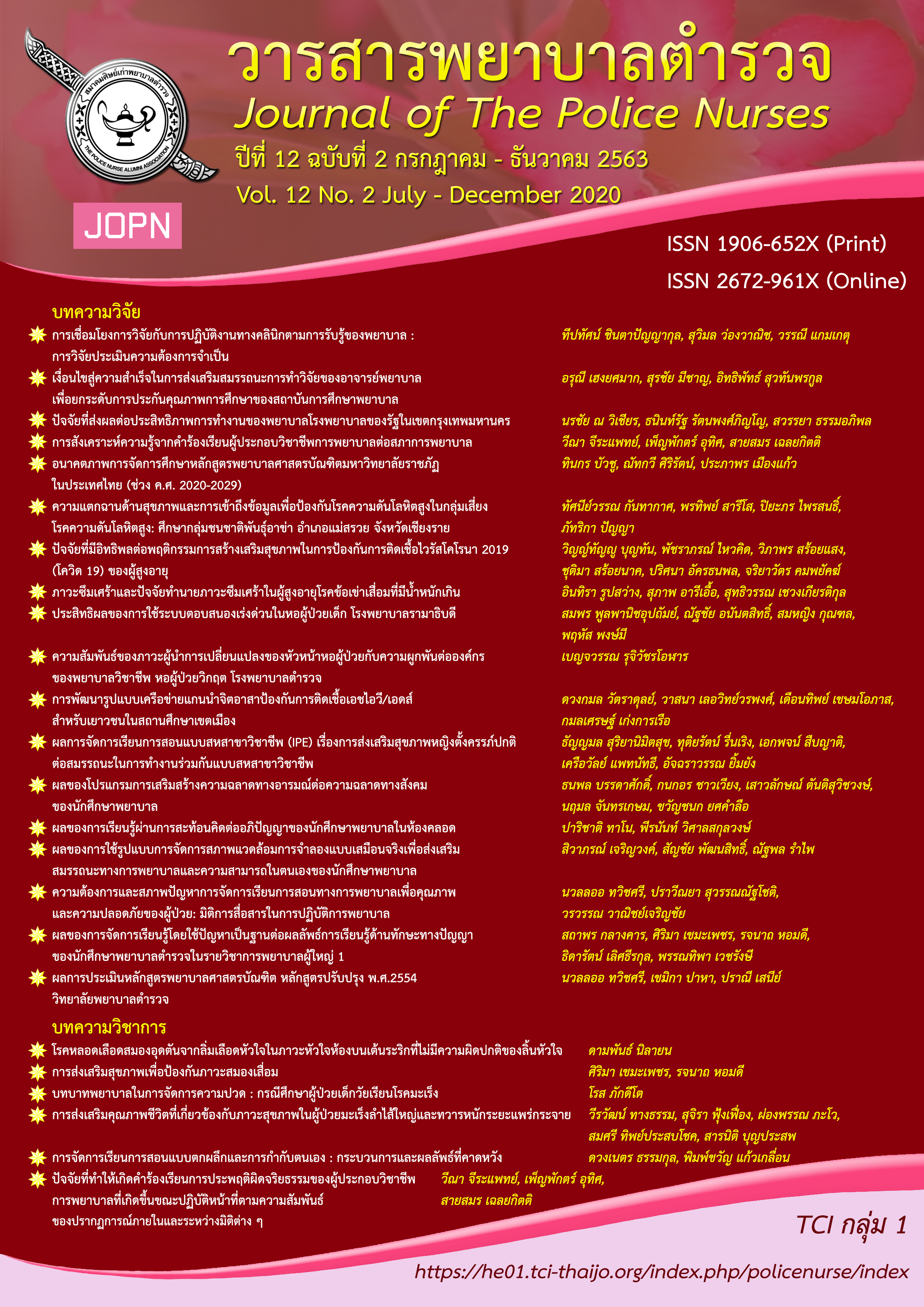ผลการจัดเรียนการสอนแบบสหสาขาวิชาชีพ (IPE) เรื่องการส่งเสริมสุขภาพหญิงตั้งครรภ์ปกติต่อสมรรถนะในการทำงานร่วมกันแบบสหสาขาวิชาชีพ
คำสำคัญ:
การจัดการเรียนการสอนแบบสหสาขาวิชาชีพ, สมรรถนะในการทำงานร่วมกันแบบสหสาขาวิชาชีพบทคัดย่อ
การวิจัยกึ่งทดลองแบบกลุ่มเดียววัดก่อนและหลังนี้ มีวัตถุประสงค์เพื่อศึกษาสมรรถนะในการทำงานร่วมกันแบบสหสาขาวิชาชีพของนักศึกษาพยาบาลหลักสูตรพยาบาลศาสตรบัณฑิต วิทยาลัยพยาบาลบรมราชชนนี ชลบุรี และนักศึกษาหลักสูตรแพทย์แผนไทย วิทยาลัยการสาธารณสุขสิรินธร จังหวัดชลบุรีและเพื่อเปรียบเทียบสมรรถนะในการทำงานร่วมกันแบบสหสาขาวิชาชีพ ก่อนและหลังการจัดการเรียนการสอนแบบสหสาขาวิชาชีพ (IPE) เรื่องการส่งเสริมสุขภาพหญิงตั้งครรภ์ปกติ ตัวอย่างเป็นนักศึกษาหลักสูตรพยาบาลศาสตรบัณฑิต วิทยาลัยพยาบาลบรมราชชนนี ชลบุรี และนักศึกษาหลักสูตรแพทย์แผนไทย วิทยาลัยการสาธารณสุขสิรินธร จังหวัดชลบุรี จำนวน 56 คน เครื่องมือที่ใช้ในการวิจัย ได้แก่ คู่มือการจัดการศึกษาแบบสหสาขาวิชาชีพที่ผ่านการตรวจสอบความตรงเชิงเนื้อหาโดยผู้ทรงคุณวุฒิ และแบบสำรวจสมรรถนะในการทำงานร่วมกันแบบสหสาขาวิชาชีพซึ่งผ่านการตรวจสอบความเที่ยง โดยมีค่าสัมประสิทธิ์แอลฟาของครอนบาคเท่ากับ .90 วิเคราะห์ข้อมูลด้วยความถี่ ร้อยละ ค่าเฉลี่ย ส่วนเบี่ยงเบนมาตรฐาน และการทดสอบที
ผลการวิจัย พบว่า สมรรถนะในการทำงานร่วมกันแบบสหสาขาวิชาชีพของนักศึกษาพยาบาลหลักสูตรพยาบาลศาสตรบัณฑิต วิทยาลัยพยาบาลบรมราชชนนี ชลบุรี และนักศึกษาหลักสูตรแพทย์แผนไทย วิทยาลัยการสาธารณสุขสิรินธร จังหวัดชลบุรี ก่อนและหลังการเข้าร่วมกิจกรรมแตกต่างกันอย่างมีนัยสำคัญทางสถิติที่ระดับ .01 โดยหลังการเข้าร่วมกิจกรรมมีค่าเฉลี่ยสูงกว่าก่อนการเข้าร่วมกิจกรรม
Downloads
เอกสารอ้างอิง
Barr, H. (2009). An anatomy of continuing interprofessional education. Journal of Continuing Education in the Health Professional, 29(3), 147-150.
Chuenkongkaew, W. (Ed.). (2015). Interprofessional education. Bangkok: P.A. living.
Dubsok, P. (2014). Development of HIV/AIDS services ystem by multidisciplinary team and HIV peer group in Khunhan Hospital, Si Sa Ket Province. Journal of Health Science, 23(4), 667-676.
Gilbert, J. H., Yan, J., & Hoffman, S. J. (2010). A WHO report: Framework for action on interprofessional education and collaborative practice. The Journal of Allied Health, 39(Suppl 1), 196-197.
Glomjai, T., Ananchaipattana, N., & Chachvarat, T. (2020). The development of learning activities of trans-professional education (TPE) for caring of depending elderly people. Nursing Public Health and Education Journal, 21(1), 125-138.
Intaravichai, P. (2015). The Effects of communication factors and flow at work to employee engagement and organizational citizenship behavior (Master Thesis). Thammasat University, Pathumthani.
Johnson, P. J., Kozhimannil, K. B., Jou, J., Ghildayal, N., & Rockwood, T. H. (2016). Complementary and alternative medicine use among women of reproductive age in the United States. Women's health issues: official publication of the Jacobs Institute of Women's Health, 26(1), 40–47. https://doi.org/10.1016/j.whi.2015.08.009
McMillan, J. H., & Hearn, J. (2008). Student self-assessment: The key to stronger student motivation and higher achievement. Educational Horizons, 87(1),40-49.
Sethasathien, S. (2015). A model of interprofessional education (IPE) in department of physical medicine and rehabilitation, Udonthani Hospital. Journal of Thai Rehabilitation Medicine, 25(2), 65-70.
Somsap, Y., & Ingathawornwong, T. (2014). Alternative and integrated methods of healthcare used by southern Thai pregnant women. Thai Journal of Nursing Council, 29(2), 114-126.
Srisujarit, D., Heetakson, C., Keadthong, W., & Janjeang, R. (2020). The readiness for interprofessional education among undergraduate students: A case study of a volunteer camp project for higher education institutions in Surat Thani province. Journal of Nurses Association of Thailand Northern Office, 26(1), 101-111.
World Health organization. (2010). Framework for action on interprofessional education and collaborative practice. Retrieved from http://www.who.int/hrh/nursing_midwifery/en/
Yuenyow, T., Howharn, C., & Promsuan, W. (2019). Effects of interprofessional education on perception on interprofessional roles and responsibility, and teamwork. Journal of Nursing, Public Health, and Education, 20(1), 137-147.
ดาวน์โหลด
เผยแพร่แล้ว
รูปแบบการอ้างอิง
ฉบับ
ประเภทบทความ
สัญญาอนุญาต
ผลงานที่ได้ตีพิมพ์แล้วจะเป็นลิขสิทธิ์ของวารสารพยาบาลตำรวจ















